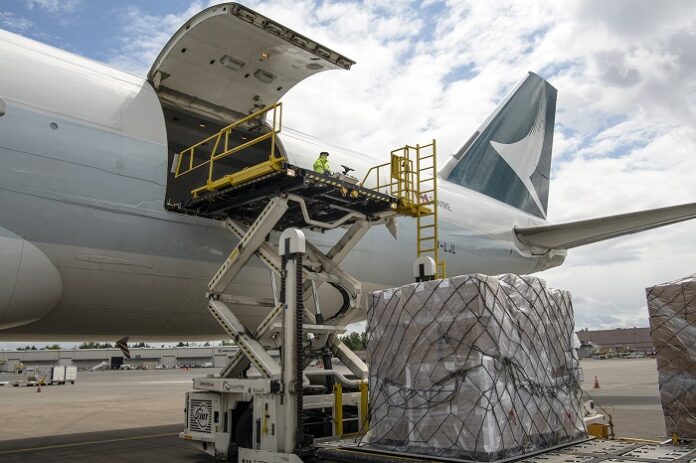
-
Xeneta analyst says Hong Kong and China still have to deal with COVID-related issues as well as global economic and geopolitical factors beyond 2023 before recovering their pre-pandemic airfreight capacity
-
Hong Kong’s passenger traffic increased after it ended its mandatory hotel quarantine, but its air cargo volume has dropped for the past two months
-
China’s strict “zero infection” policy is restricting movement amid a wave of COVID contagion in several cities
A full market recovery next year is ruled out for Hong Kong and mainland China’s airfreight industries as the world’s two busiest air cargo airports struggle against the impact of global economic and geopolitical factors as well as lingering COVID challenges, air and sea freight analytics platform Xeneta says.
In an airfreight blog update focusing on both markets, Xeneta analyst Wenwen Zhang said Hong Kong International Airport was the world’s busiest cargo airport in 2021 when measured in weight, but it had to deal with strict pandemic-related restrictions this year.
Hong Kong eased its quarantine for inbound travelers on September 26, keeping only a three-day medical surveillance in place. In contrast, China is strictly sticking with its “zero infection” policy as it battles a spreading COVID wave that’s hampering travel and economic activity.
Zhang said that the Civil Aviation Administration of China’s September international passenger traffic figure as only 3% of the throughput in September 2019.
Airport Authority Hong Kong announced this month HKIA passenger traffic in October reached 755,000, up 447.9% year on year and around 13% of pre-pandemic levels. Cargo throughput slid 23.9% y-o-y to 351,000 tons and flight movements fell 10.2% to 12,575.
Related report: Cathay’s Oct passenger count up 425%, cargo dips
AAHK said cargo volume remained affected by global economic uncertainties, geopolitical tensions and global supply chain disruptions. Exports and imports fell 26% and 29% y-o-y with cargo traffic to and from North America declining the most.
In January-October, HKIA handled 3 million passengers, a 179.0% y-o-y spike. Its cargo volume fell 14.1% to 3.5 million tons and flight movements slipped 5.3% to 109,270.
On a 12-month rolling basis, HKIA handled 3.3 million passengers, up 162.6% y-o-y, and 4.5 million tons of cargo and 138,650 flight movements, down 10.0% and 1.4%.
Zhang said Hong Kong outbound air cargo capacity peaked year-to-date 21% in the first half of November vs. the week before restrictions eased on September 26.
Belly capacity grew 69% as passenger numbers grew. Overall air cargo capacity was subdued. For example, capacity was still down 5% y-o-y and 18% below the pre-pandemic levels.
Zhang said despite the recent growth, belly capacity in the first half of November was still 72% lower than its pre-pandemic level.
Year-to-date air cargo volumes out of Hong Kong are 16% below 2021 and 11% lower than in 2019, Zhang said.
She said with the increased cargo capacity and falling volume, dynamic load factor measuring aircraft capacity utilization by cargo volume and weight continued to trend downward.
In Week 2 of November, the load factor for the outbound Hong Kong market stood at 84%, 7 percentage points lower than the load factor in 2019.
There’s no sign of a peak season this year with rates out of Hong Kong down 12% y-o-y.
Looking at top volume corridors, the Hong Kong-Europe average airfreight rate was US$5.97/kg in Week 2 of November after declining since the pre-Golden Week cargo rush. The rate on this corridor is down 12% y-o-y but remains 85% above pre-COVID levels.
The Hong Kong-North America average rate in the same week was $5.71 per kg as war has less impact on this corridor, the inbound North American rate fell a steeper 44% than Europe’s from the same week last year and “only” 56% above the pre-COVID level.
Hong Kong is giving away 500,000 airline tickets, but that’s unlikely to help its airfreight market recover fully until 2024, as the three-day medical surveillance for arrivals is turning off foreign travelers, Zhang said.
She said 4 in 5 travelers to Hong Kong are from China, which is largely closed to the rest of the world such that regional air cargo belly capacity in and out of Hong Kong is unlikely to recover substantially.
Xeneta’s data for the week to November 13 show China’s passenger belly capacity at 89% below the pre-pandemic level.
This winter until March 31, 2023, CAAC says Chinese and foreign airlines have scheduled 840 weekly passenger flights and 6,148 weekly cargo flights for international routes, up 106% and 7% versus last winter.
While China is taking steps to loosen COVID restrictions, this is unlikely to boost international travel substantially with all inbound travelers still required to undergo a compulsory 5-day quarantine and 3 days of home isolation.
One exception with a likely significant effect is China’s ending the “circuit breaker” mechanism, in which an inbound flight is suspended if it carries a certain number of passengers who test positive for COVID. Removing this mechanism ended the uncertainty of international travel.
Overall, a recovery next year is ruled out for China’s air cargo market, Zhang said.




